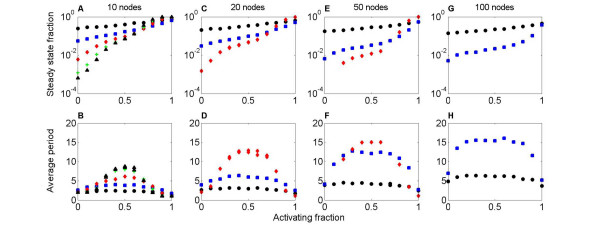Figure 2.
The activating fraction and dynamics of random (Erdös-Renyi) networks. A, C, E, G: Fraction of networks whose dynamics reach steady state, as a function of activating fraction a. B, D, F, H: Average oscillation period of network dynamics, as a function of a. The network size is 10 (A, B), 20 (C, D), 50 (E, F), or 100 (G, H). The number of connections per node is 1 (black circle), 2 (blue square), 5 (red diamond) 8 (green +), or 10 (black triangle). For a near 1, the network dynamics are highly likely to reach steady state, independent of other parameters (A, C, E, G). For a near 0, the steady state fraction is between 7 × 10-4 and 0.25, depending on the network degree. For a near 1, the average period is close 1, which corresponds to steady state (B, D, F, H). For a near 0, the period is close to 2, because the activity of network nodes oscillates between off and on. For a near 0.5, the period has a maximum. The maximum oscillation period increases with the size and degree of the network.

